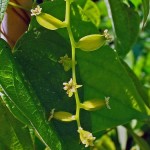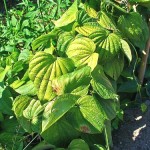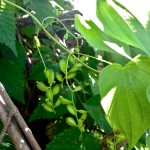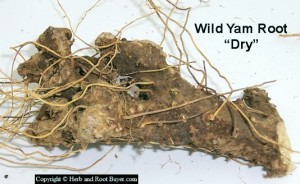Wild Yam – Dioscorea villosa
|
Current Demand = Normal |
Parts Used: Rhizome |
 |
 |
 |
 |
Family: Dioscoreaceae
Common Names: Dioscorea, Colic Root, Rheumatism Root, Wilde Yamwurzel, wild Mexican yam, rheumatism root, Chinese yam, shan yao…
Description:
The Wild Yam is a perennial climbing vine native to Eastern North American. In the central and southern US, it is found in damp woods, thickets, roadside fences, hedges and swamps and along timber trails and shady ravines. This plant has long, knotty, matted, ligneous, woody roots that are tasteless initially, but are acidic afterward. The roots run horizontal beneath the surface. They are light brown outside and white fibrous inside.
The leaves are heart-shaped with prominent veins that run from the center top of the heart out into a fan pattern. The leaves run alternately and grow in twos and fours. The flowers are small and greenish-white and the drooping cluster of 3-6 inches (male) and the spear-like heads sit on top of the winged fruit (female). They bloom in early summer until late August. The stems can reach lengths of 30 feet and tend to twist right to left.
Harvesting/Drying:
Part Used: Dried rhizome
For maximum potency wild yam root should be harvested in the late summer and fall. Late season harvest will allow the plant to seed. Most times, only the plants roots have market value although occasionally buyers will purchase freshly dug whole plants. Gather the larger more mature plants leaving plenty of younger smaller plants to seed the area for future harvest.
After harvest, the roots should be washed in cold water and all foreign matter (rocks, dirt and other roots) must be removed. Unless your buyer is purchasing fresh dug roots (which they often do) the clean roots need to be dried. Large roots may need to be broken in half or chopped into smaller two or three inch pieces to aid in drying.
Wild yam can be dried in the sun although if possible dry indoors in a well ventilated barn loft or attic to protect the roots from the elements. If natural heat is not available you may need to add heat and a fan for continuous airflow.
The key to drying any root, herb or bark in an even combination of heat and airflow. Never use an oven or microwave.
Wild yam root will be completely dry (largest stem will snap not bend) in 5-10 days depending on the size of the root and the drying conditions. Place the herb carefully into a cardboard box or paper bag for storage in a dry area until you are ready to sell or use. Do not store the roots in plastic or it will mold. Always allow plenty of time for your crop to dry for maximum value.
Planting/Cultivation:
Growing region: Wild yam can be found in the Eastern United States and Southeastern Canada. It is common thru-out the Midwest and Appalachia, North to Minnesota, west to Texas and south to Georgia. Large populations can be found in West Virginia, Kentucky, Ohio, Indiana and Tennessee.
This plant prefers light, medium, and heavy soils that is well-drained. It cannot grow in the shade and requires moist soil.
Propagation:
Cuttings: root cuttings can be taken in the winter or late fall. These pea size tubercles should be planted immediately into individual containers and kept in a greenhouse over the winter, then planted in spring into permanent homes. The plant only has one sex, so both male and female plants must be grown if you need seeds.
Seeds: sow the seeds in a sunny area in a warm greenhouse and just barely cover. They germinate in 1-3 weeks. Prick out the seedlings as soon as large enough to handle and place in individual pots. Keep indoors the first winter, transplant in late spring. See harvesting/drying next
Attributes (Images)
By H. Zell (Own work) [GFDL or CC BY-SA 3.0], via Wikimedia Commons
By Fritzflohrreynolds (Own work) [CC BY-SA 3.0], via Wikimedia Commons
 Root Buyer
Root Buyer